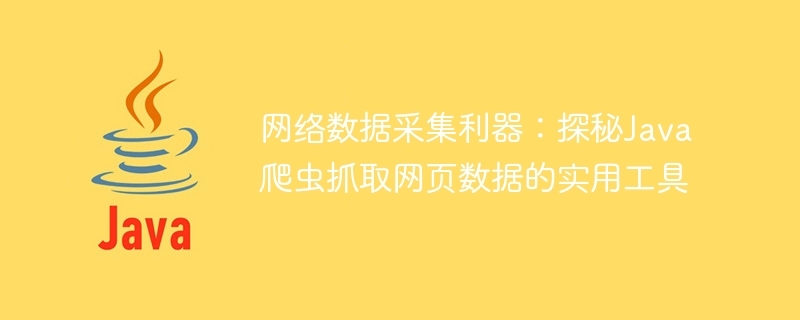Java爬虫工具:揭秘网络数据采集利器,抓取网页数据的实用工具
- WBOY原创
- 2024-01-05 17:29:451208浏览

Java爬虫工具:揭秘网络数据采集利器,抓取网页数据的实用工具
导语:随着互联网的发展,海量的数据被不断产生和更新,对这些数据进行采集和处理,成为了许多企业和个人的需求。为了满足这一需求,爬虫技术应运而生。本文将探讨Java语言下,用于抓取网页数据的实用工具,并附带具体代码示例。
爬虫技术简介
爬虫技术是指利用程序自动化地访问并分析网络数据,从而获取所需的信息。在Java领域中,常用的爬虫实现方式包括使用HttpURLConnection、Jsoup和HttpClient三个工具。下面分别介绍这三种工具的使用方法。
- HttpURLConnection
HttpURLConnection是Java自带的一个包,用于发送HTTP请求和接收HTTP响应。通过用HttpURLConnection读取网页的HTML代码,可以获取到相关的数据。
下面是一个使用HttpURLConnection实现简单爬虫功能的示例代码:
import java.io.BufferedReader;
import java.io.IOException;
import java.io.InputStreamReader;
import java.net.HttpURLConnection;
import java.net.URL;
public class HttpURLConnectionExample {
public static void main(String[] args) throws IOException {
// 设置需要爬取的URL
String url = "http://example.com";
// 创建URL对象
URL obj = new URL(url);
// 打开连接
HttpURLConnection con = (HttpURLConnection) obj.openConnection();
// 获取响应码
int responseCode = con.getResponseCode();
System.out.println("Response Code: " + responseCode);
// 创建BufferedReader对象,读取网页内容
BufferedReader in = new BufferedReader(new InputStreamReader(con.getInputStream()));
String inputLine;
StringBuilder content = new StringBuilder();
while ((inputLine = in.readLine()) != null) {
content.append(inputLine);
}
in.close();
// 输出网页内容
System.out.println(content);
}
}- Jsoup
Jsoup是一款非常强大的Java HTML解析器,可用于解析、处理和操作HTML文档。使用Jsoup,我们可以轻松地获取网页提取所需的数据。
下面是一个使用Jsoup实现爬虫功能的示例代码:
import org.jsoup.Jsoup;
import org.jsoup.nodes.Document;
import org.jsoup.nodes.Element;
import org.jsoup.select.Elements;
import java.io.IOException;
public class JsoupExample {
public static void main(String[] args) throws IOException {
// 设置需要爬取的URL
String url = "http://example.com";
// 使用Jsoup连接到网页
Document doc = Jsoup.connect(url).get();
// 获取所有的a标签
Elements links = doc.getElementsByTag("a");
for (Element link : links) {
// 输出a标签的href属性值和文本内容
System.out.println("Link: " + link.attr("href") + ", Text: " + link.text());
}
}
}- HttpClient
HttpClient是Apache开源组织提供的一个Java库,用于发送HTTP请求和处理HTTP响应。相比于HttpURLConnection,HttpClient具有更加灵活和强大的功能。
下面是一个使用HttpClient实现爬虫功能的示例代码:
import org.apache.http.HttpEntity;
import org.apache.http.HttpResponse;
import org.apache.http.client.HttpClient;
import org.apache.http.client.methods.HttpGet;
import org.apache.http.impl.client.DefaultHttpClient;
import org.apache.http.util.EntityUtils;
import java.io.IOException;
public class HttpClientExample {
public static void main(String[] args) throws IOException {
// 设置需要爬取的URL
String url = "http://example.com";
// 创建HttpClient对象
HttpClient client = new DefaultHttpClient();
// 创建HttpGet对象,设置URL
HttpGet request = new HttpGet(url);
// 发送HTTP请求
HttpResponse response = client.execute(request);
// 获取响应实体
HttpEntity entity = response.getEntity();
// 将实体转为字符串
String content = EntityUtils.toString(entity);
// 输出网页内容
System.out.println(content);
}
}总结
本文介绍了在Java语言下利用HttpURLConnection、Jsoup和HttpClient三个工具进行爬虫的方法,并附带相应的代码示例。这些工具具有各自的特点和优势,在实际开发中根据需求选择合适的工具非常重要。同时,我们也需要注意合法合规地使用爬虫技术,遵守法律和道德规范,确保数据采集行为的合法性。
以上是Java爬虫工具:揭秘网络数据采集利器,抓取网页数据的实用工具的详细内容。更多信息请关注PHP中文网其他相关文章!
声明:
本文内容由网友自发贡献,版权归原作者所有,本站不承担相应法律责任。如您发现有涉嫌抄袭侵权的内容,请联系admin@php.cn

